Chart Color Schemes
est. as @ -- *
ABS ERP | -- people | --
2021 Census | -- people
Sales Activity
Curious about local property values? Filter the chart to assess the volume and appreciation (including resales) trends and regional comparisons, or scroll to the map below view this information at an individual property level.
Find a Recent Sale
Sales Detail
Population
An assessment of population growth drivers in Torrens reveals an overall ranking slightly below national averages considering recent, and medium term trends
Torrens' population is approximately 2,423 as of August 2025. This shows a decrease of 1 person from the 2021 Census figure of 2,424 people. The change is inferred from ABS estimates: 2,418 residents in June 2024 and an additional 10 validated addresses since the Census date. Population density is around 1,863 persons per square kilometer, exceeding national averages according to AreaSearch assessments. Overseas migration contributed approximately 71.2% of recent population gains.
AreaSearch uses ABS/Geoscience Australia projections for each SA2 area, released in 2024 with a base year of 2022. For areas not covered by this data and years post-2032, ACT Government's SA2 area projections are adopted. By 2041, population is projected to decline by 169 persons. However, specific age cohorts like the 65 to 74 group are expected to grow, with a projected increase of 28 people.
Frequently Asked Questions - Population
Development
Residential development activity is lower than average in Torrens according to AreaSearch's national comparison of local real estate markets
Torrens has seen approximately 10 new homes approved annually over the past five financial years, totalling 51 homes. As of FY26, there has been one approval recorded so far. Each dwelling built in Torrens over these years has resulted in an average of 2.2 new residents per year, indicating strong demand that supports property values. The average expected construction cost value for new homes is $306,000.
In FY26, there have been $132,000 in commercial development approvals recorded, suggesting minimal commercial development activity compared to residential. Compared to the Australian Capital Territory, Torrens has markedly lower building activity, 74.0% below the regional average per person. This scarcity of new dwellings typically strengthens demand and prices for existing properties. New developments consist of 88.0% standalone homes and 12.0% medium and high-density housing, maintaining Torrens' traditional suburban character with a focus on family homes.
With around 444 people per approval, Torrens indicates a mature market. Given stable or declining population forecasts, Torrens may experience less housing pressure in the future, creating favourable conditions for buyers.
Frequently Asked Questions - Development
Infrastructure
Torrens has strong levels of nearby infrastructure activity, ranking in the top 40% nationally
No changes can significantly affect a region's performance like alterations to local infrastructure, major projects, and planning initiatives. Zero projects have been identified by AreaSearch that could potentially impact this area. Notable projects include Athllon Drive Duplication, Mawson Group Centre Upgrade, Mixed-Use Complex In Mawson, and Canberra Hospital Master Plan, with the following list outlining those likely to be most relevant.
Professional plan users can use the search below to filter and access additional projects.
INFRASTRUCTURE SEARCH
 Denotes AI-based impression for illustrative purposes only, not to be taken as definitive under any circumstances. Please follow links and conduct other investigations from the project's source for actual imagery. Developers and project owners wishing us to use original imagery please Contact Us and we will do so.
Denotes AI-based impression for illustrative purposes only, not to be taken as definitive under any circumstances. Please follow links and conduct other investigations from the project's source for actual imagery. Developers and project owners wishing us to use original imagery please Contact Us and we will do so.
Frequently Asked Questions - Infrastructure
Low and Mid-Rise Housing Policy
State-wide NSW planning reforms via amendments to the State Environmental Planning Policy to enable more diverse low and mid-rise housing (dual occupancies, terraces, townhouses, manor houses and residential flat buildings up to 6 storeys) in well-located areas within 800 m of selected train, metro and light-rail stations and town centres. Stage 1 (dual occupancies in R2 zones statewide) commenced 1 July 2024. Stage 2 (mid-rise apartments, terraces and dual occupancies near stations) commenced 28 February 2025. Expected to facilitate up to 112,000 additional homes over the next five years.
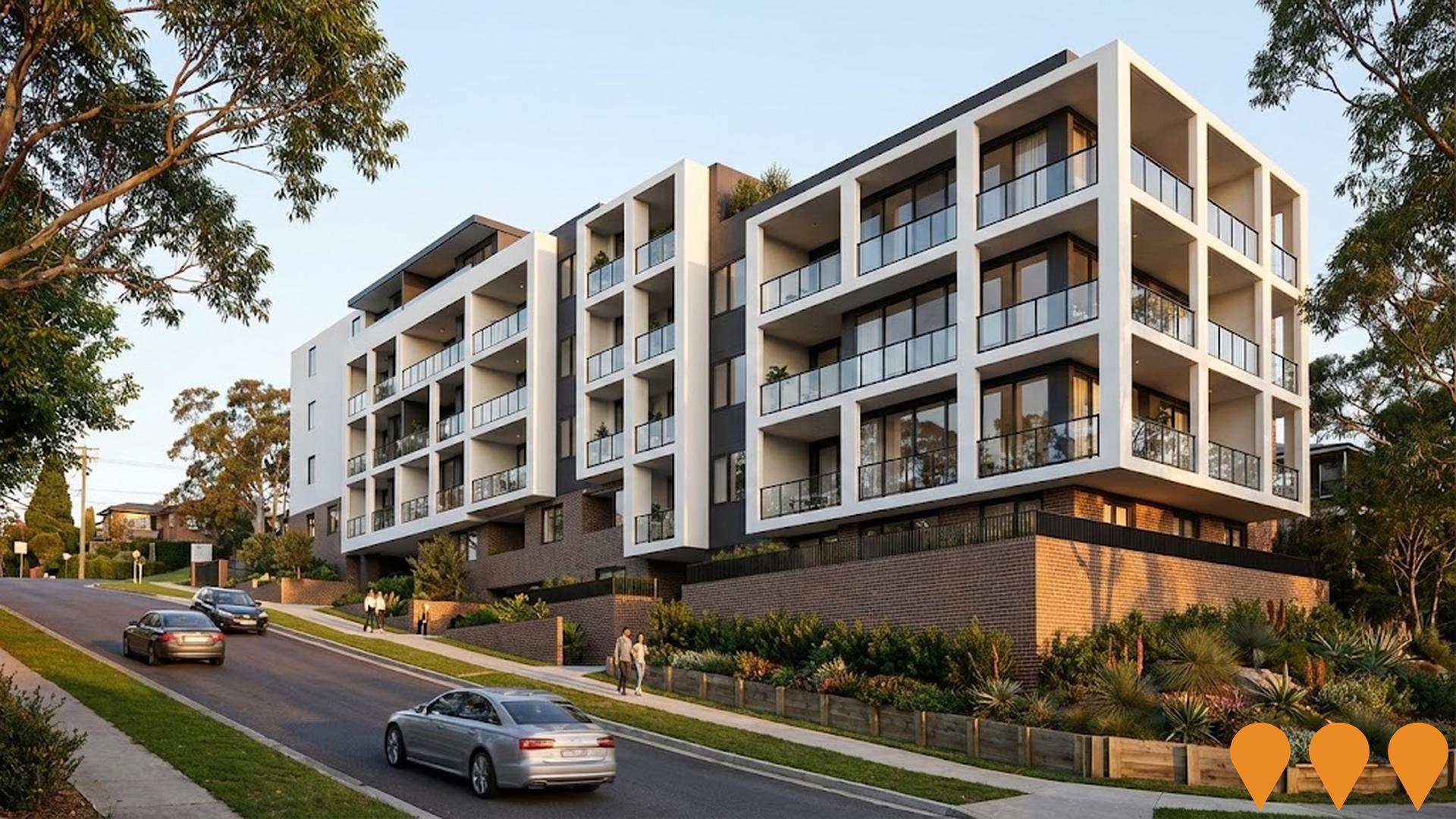
Canberra Hospital Master Plan
Long-term transformation of Canberra Hospital campus (2021-2041). The new Critical Services Building (Building 5) opened in 2023. Multiple stages are now in construction or detailed planning, including SPIRE Stage 1 (new emergency, surgical and intensive care facilities) and ongoing campus renewal works to deliver modern clinical facilities.

Canberra Light Rail Stage 4 - Woden to Tuggeranong
Proposed extension of Canberra's light rail network from Woden Town Centre south to Tuggeranong Town Centre via Mawson and the Athllon Drive corridor. This future stage aims to complete the north-south radial mass transit spine, connecting major residential, employment and activity centres while supporting bus, cycling, walking and private vehicle integration.
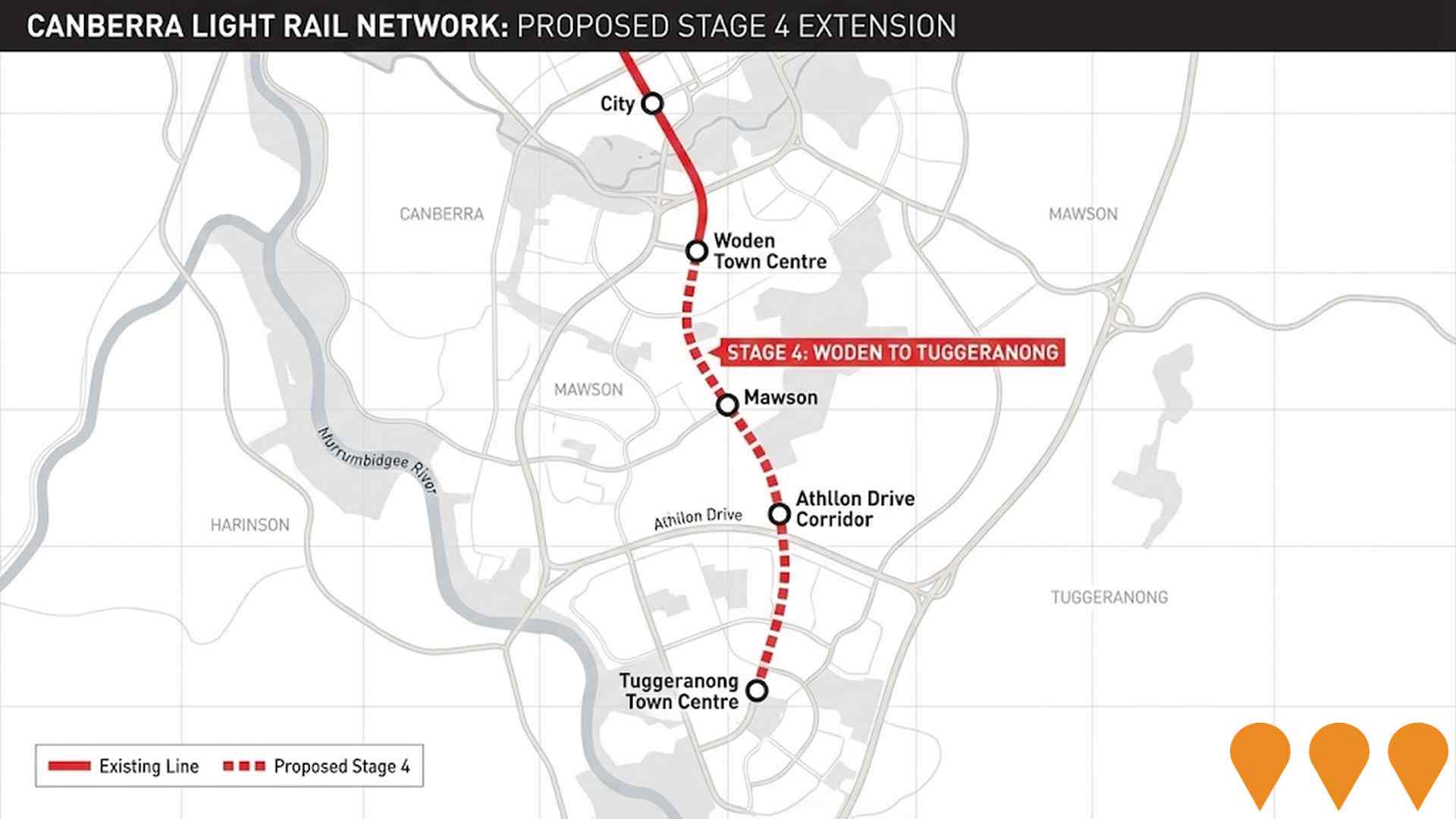
Athllon Drive Duplication
The Athllon Drive duplication project upgrades a key arterial road from Woden to Tuggeranong. It includes duplicating 2.4 km between Sulwood Drive and Drakeford Drive, and 600 m between Hindmarsh Drive and Melrose Drive. Features encompass lane duplication, new traffic lights at multiple intersections, upgraded bus stops, active travel paths for cyclists and pedestrians, water quality improvements for Lake Tuggeranong, and a new underpass under Sulwood Drive. Enabling works commenced in 2024 and continue into 2025, with main construction anticipated to span 2-3 years post-planning approvals. The initiative enhances safety, reduces congestion, and supports public transport and future urban growth.
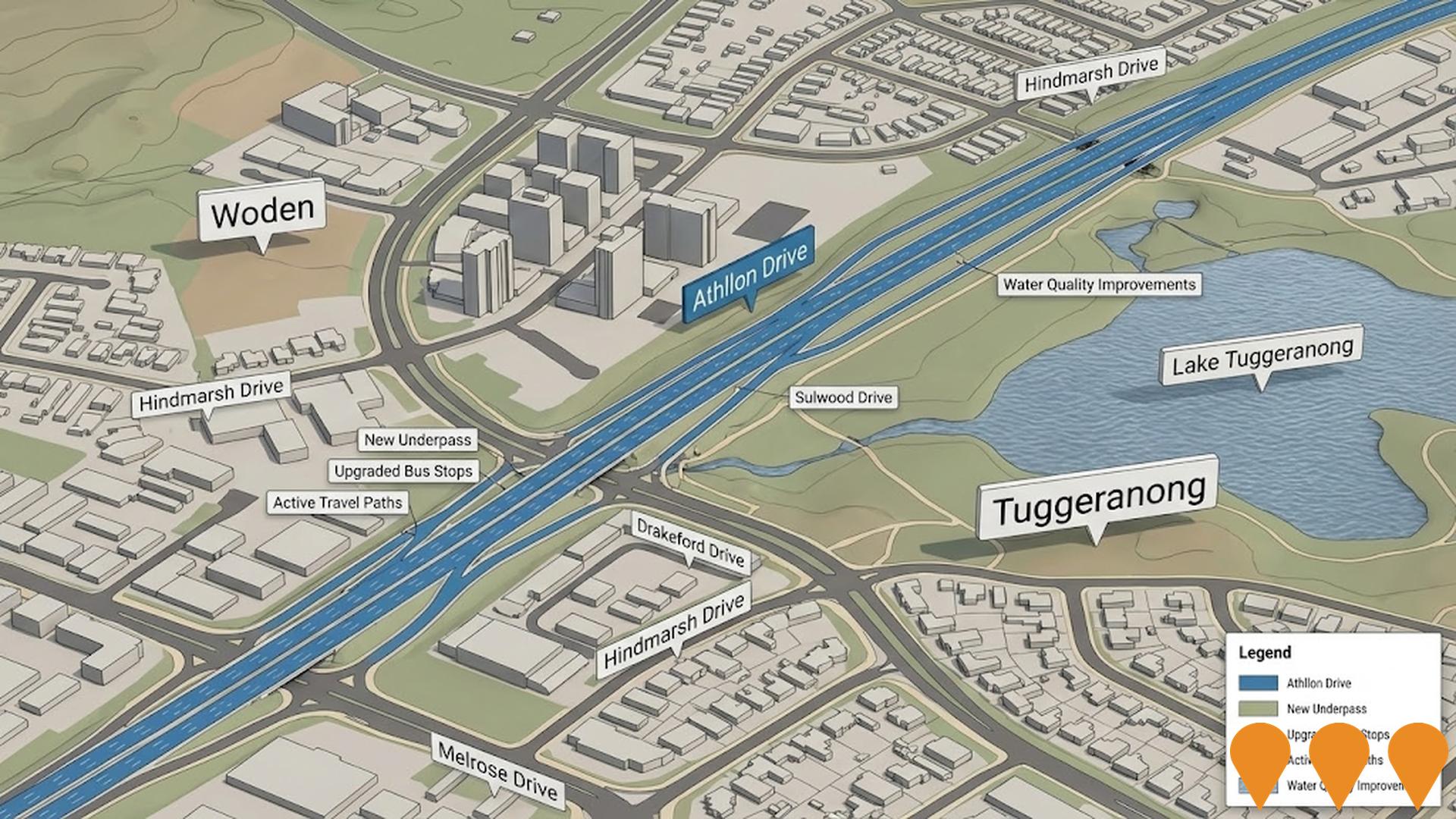
Enhanced bus and light rail corridors (Belconnen & Queanbeyan to Central Canberra)
ACT is progressing an integrated program to enhance high-frequency bus and future light rail corridors that link Belconnen and Queanbeyan with central Canberra. Light Rail Stage 2A (City to Commonwealth Park) commenced construction in early 2025 with services targeted from 2028, while planning and approvals continue for Stage 2B to Woden. The ACT Government has acknowledged and is planning upgrades for the Belconnen-to-City bus corridor as groundwork for a future east-west light rail Stage 3, and is coordinating cross-border public transport initiatives with NSW through the Queanbeyan Region Integrated Transport Plan and the ACT-NSW MoU for Regional Collaboration.
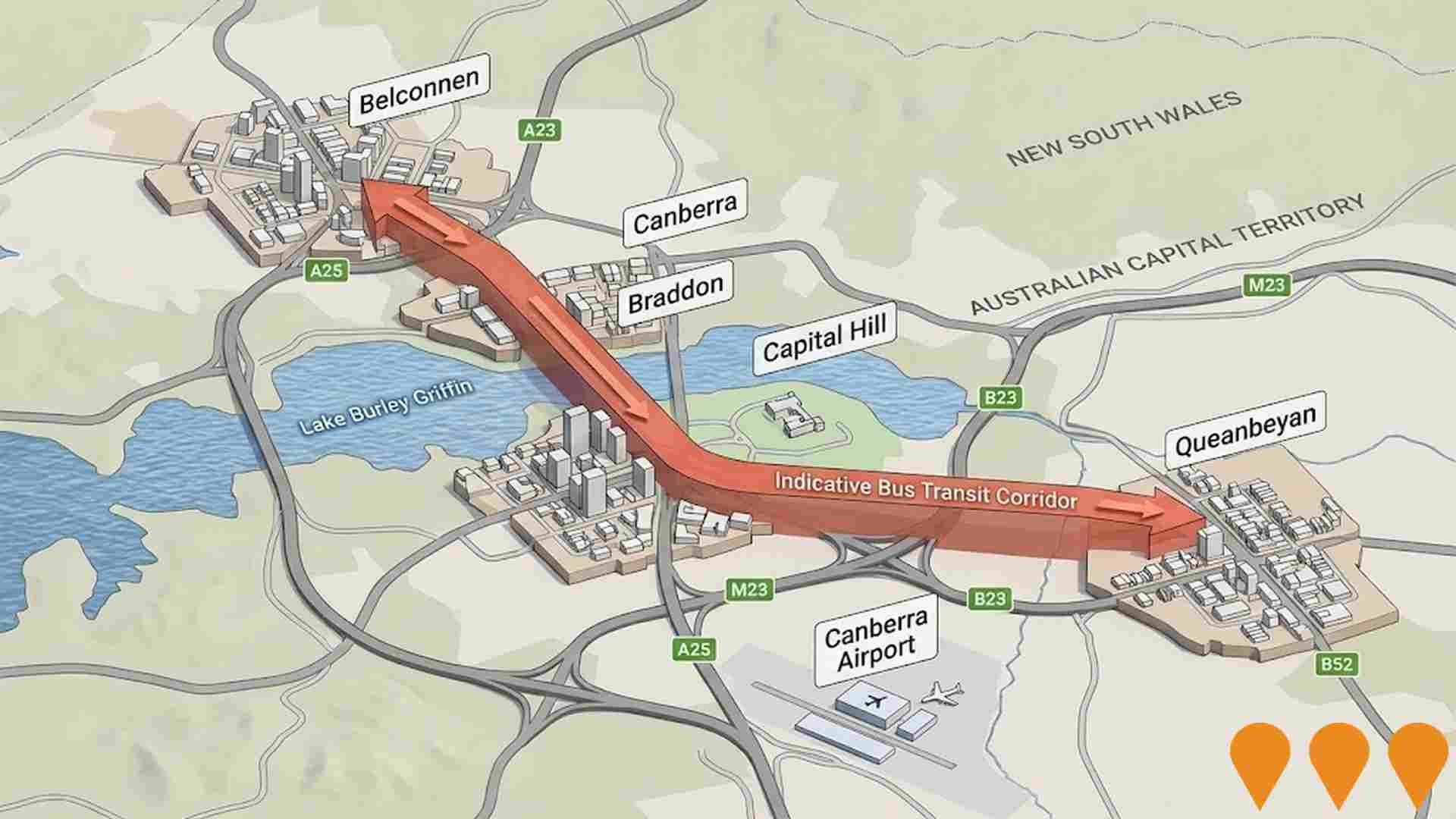
HumeLink
HumeLink is a new 500kV transmission line project connecting Wagga Wagga, Bannaby, and Maragle, spanning approximately 365 km. It includes new or upgraded infrastructure at four locations and aims to enhance the reliability and sustainability of the national electricity grid by increasing the integration of renewable energy sources such as wind and solar.
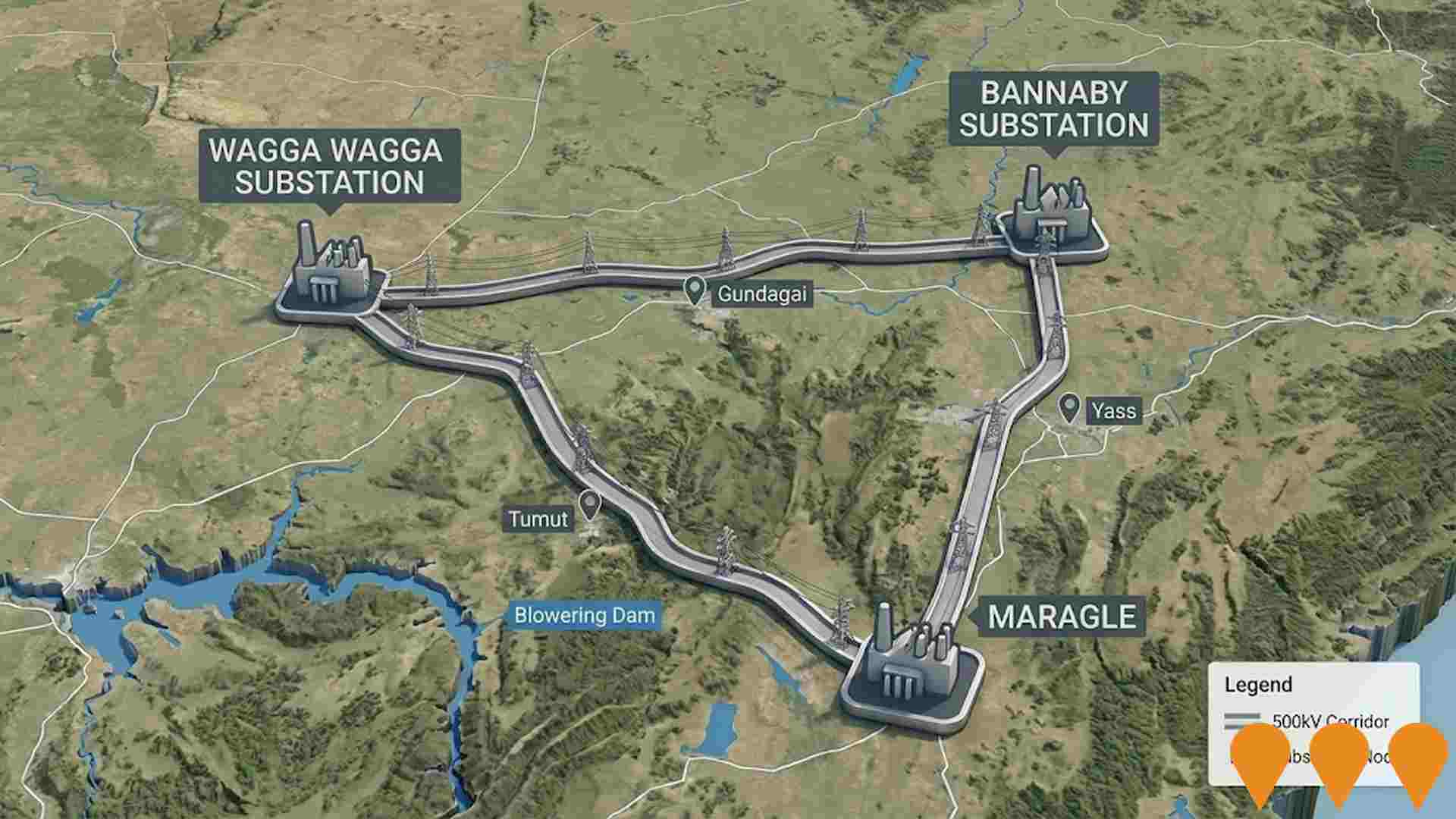
Queanbeyan Regional Integrated Transport Plan
Comprehensive transport planning initiative with 64 key actions for next 10 years. Addresses road safety, active transport connectivity, public transport availability, and future transport needs. Improved connections between Queanbeyan and ACT.
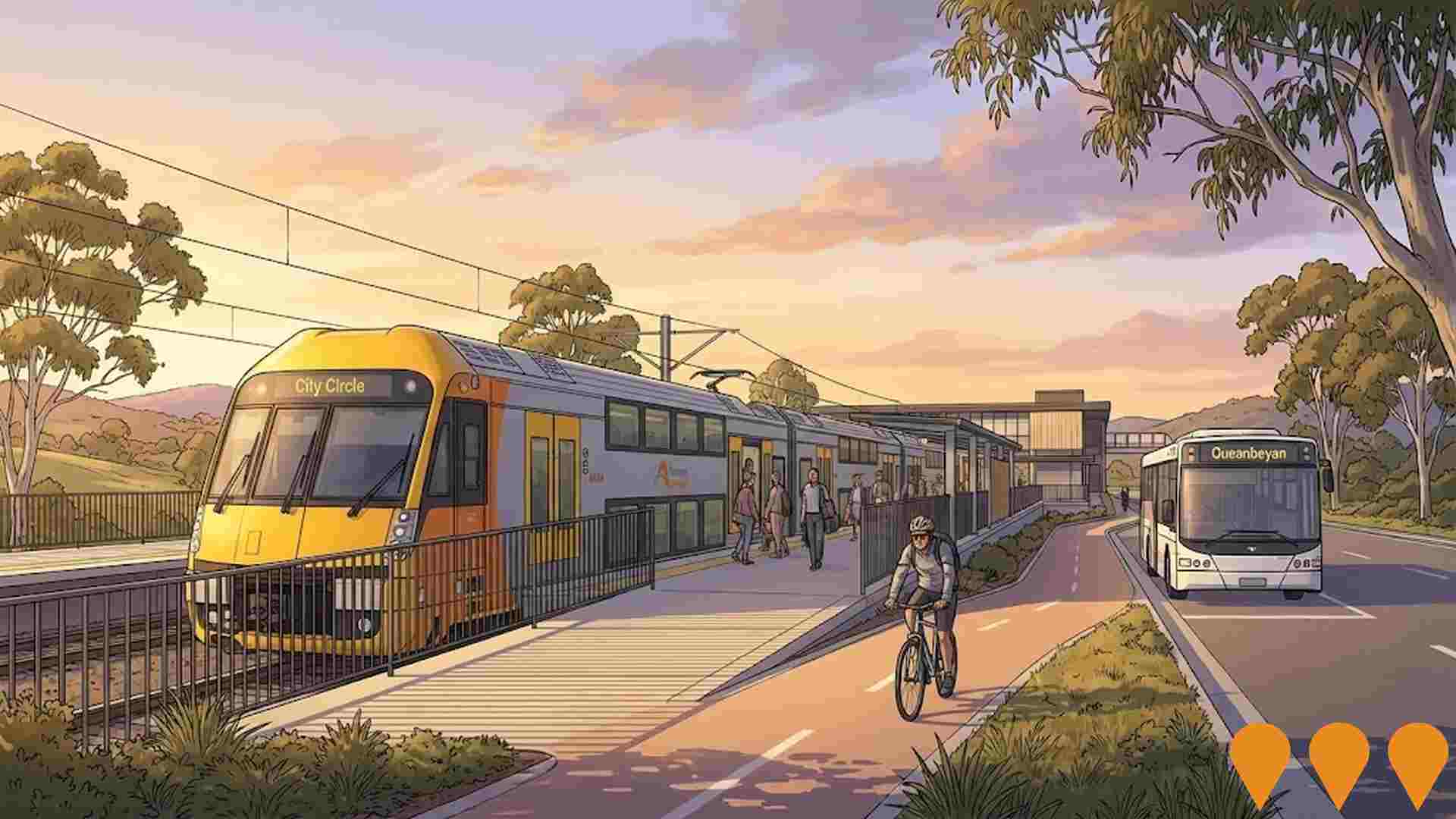
Big Canberra Battery (Williamsdale BESS)
A 250 MW / 500 MWh battery energy storage system at Williamsdale in southern Canberra, delivered by Eku Energy as Stream 1 of the ACT Government's Big Canberra Battery. Construction commenced in November 2024 with partners CPP and Tesla supplying Megapack systems. The asset will connect to Evoenergy's 132 kV network near the Williamsdale substation to provide two hours of dispatchable power, grid services and reliability for the ACT. Target operations in 2026.
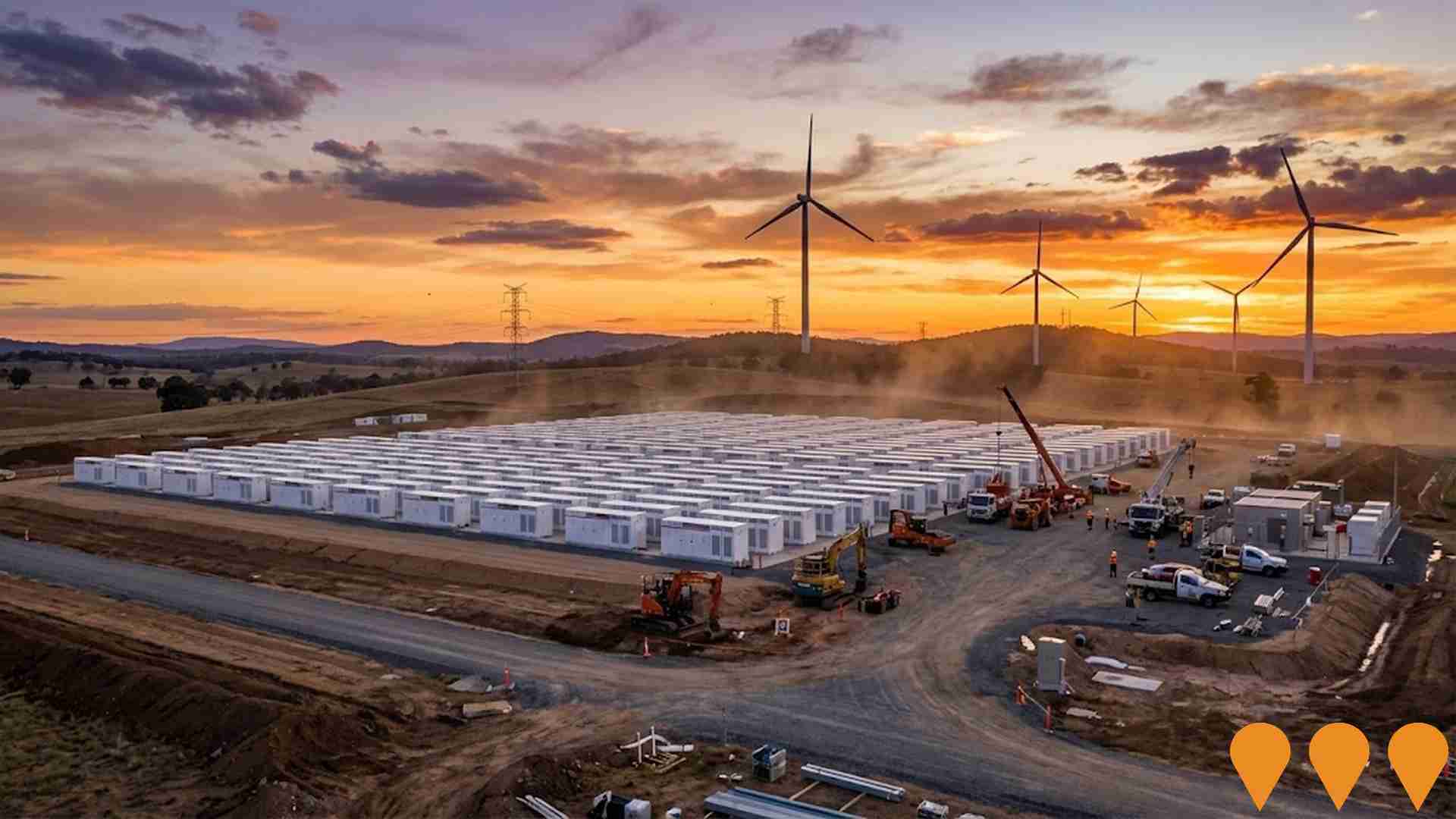
Employment
AreaSearch analysis places Torrens well above average for employment performance across multiple indicators
Torrens has a highly educated workforce with strong professional services representation. Its unemployment rate was 2.5% in the past year, with an estimated employment growth of 2.4%.
As of June 2025, 1,318 residents were employed, with an unemployment rate of 0.9% below the Australian Capital Territory's rate of 3.4%, and workforce participation at 66.8%. Dominant sectors include public administration & safety, health care & social assistance, and professional & technical services. Conversely, accommodation & food services had lower representation at 4.7% compared to the regional average of 6.5%.
The area offers limited local employment opportunities, as indicated by Census data comparing working population to resident population. Between June 2024 and June 2025, employment increased by 2.4%, labour force by 1.6%, decreasing unemployment rate by 0.8 percentage points. In contrast, Australian Capital Territory saw employment growth of 1.9% and labour force growth of 1.6%, with a 0.3 percentage point drop in unemployment rate. Jobs and Skills Australia's national employment forecasts from May 2025 project national employment growth of 6.6% over five years and 13.7% over ten years, varying significantly between sectors. Applying these projections to Torrens' employment mix suggests local growth of approximately 6.8% over five years and 13.8% over ten years.
Frequently Asked Questions - Employment
Income
The economic profile demonstrates exceptional strength, placing the area among the top 10% nationally based on comprehensive AreaSearch income analysis
AreaSearch's latest postcode level ATO data for financial year 2022 shows that income in Torrens is exceptionally high nationally. The median assessed income is $72,953 while the average income stands at $97,554. This contrasts with Australian Capital Territory's figures of a median income of $68,678 and an average income of $83,634. Based on Wage Price Index growth of 13.6% since financial year 2022, current estimates would be approximately $82,875 (median) and $110,821 (average) as of September 2025. Census data reveals that household, family and personal incomes all rank highly in Torrens, between the 93rd and 94th percentiles nationally. Income brackets indicate that 30.6% of the population (741 individuals) fall within the $4000+ income range, contrasting with the region where the $1,500 - 2,999 bracket leads at 34.3%. Economic strength emerges through 45.6% of households achieving high weekly earnings exceeding $3,000, supporting elevated consumer spending. After housing costs, residents retain 87.0% of income, reflecting strong purchasing power and the area's SEIFA income ranking places it in the 9th decile.
Frequently Asked Questions - Income
Housing
Torrens is characterized by a predominantly suburban housing profile, with above-average rates of outright home ownership
In Torrens, as per the latest Census evaluation, 84.8% of dwellings were houses while 15.2% consisted of other types such as semi-detached homes, apartments and 'other' dwellings. This is compared to the Australian Capital Territory's figures of 58.4% houses and 41.7% other dwellings. Home ownership in Torrens stood at 36.2%, with mortgaged dwellings at 38.7% and rented ones at 25.1%. The median monthly mortgage repayment in the area was $2,470, higher than the Australian Capital Territory average of $2,167. The median weekly rent figure in Torrens was $478, compared to $440 in the Australian Capital Territory. Nationally, Torrens' mortgage repayments were significantly higher at $2,470 compared to the Australian average of $1,863, while rents were substantially higher at $478 than the national figure of $375.
Frequently Asked Questions - Housing
Household Composition
Torrens has a typical household mix, with a higher-than-average median household size
Family households account for 74.2% of all households, including 38.5% couples with children, 24.5% couples without children, and 10.1% single parent families. Non-family households constitute the remaining 25.8%, with lone person households at 22.2% and group households comprising 3.6%. The median household size is 2.7 people, which is larger than the Australian Capital Territory average of 2.4.
Frequently Asked Questions - Households
Local Schools & Education
Torrens shows strong educational performance, ranking in the upper quartile nationally when assessed across multiple qualification and achievement indicators
Educational attainment in Torrens is notably higher than national averages. As of 2021, 48.6% of residents aged 15 and above hold university qualifications, compared to the Australian average of 30.4%. Bachelor degrees are most prevalent at 29.3%, followed by postgraduate qualifications (13.9%) and graduate diplomas (5.4%). Vocational pathways account for 24.0% of qualifications among those aged 15 and above, with advanced diplomas making up 9.3% and certificates 14.7%.
Educational participation is high, with 32.5% of residents currently enrolled in formal education as of the latest data. This includes 11.3% in primary education, 9.4% in secondary education, and 6.1% pursuing tertiary education. Torrens Primary School serves the local educational needs within Torrens, with an enrollment of 397 students as of 2022. The school focuses exclusively on primary education, with ICSEA scores indicating above-average socio-educational conditions (1092). Secondary educational options are available in surrounding areas.
Frequently Asked Questions - Education
Schools Detail
Nearby Services & Amenities
Transport
Transport servicing is good compared to other areas nationally based on assessment of service frequency, route connectivity and accessibility
Torrens has 11 operating public transport stops, all bus services. Four routes serve these stops, offering 1,386 weekly passenger trips in total. Residents enjoy good transport accessibility, with an average distance of 229 meters to the nearest stop.
Daily service frequency averages 198 trips across all routes, equating to about 126 weekly trips per individual stop.
Frequently Asked Questions - Transport
Transport Stops Detail
Health
The level of general health in Torrens is notably higher than the national average with a fairly standard level of common health conditions seen across both young and old age cohorts
Torrens demonstrates above-average health outcomes. The rate of private health cover is exceptionally high at approximately 70% of the total population (1,691 people), compared to the national average of 55.3%.
The most common medical conditions are asthma and mental health issues, impacting 8.0% and 8.0% of residents respectively. Seventy point nine percent declared themselves completely clear of medical ailments, compared to 70.1% across Australian Capital Territory. Fifteen point nine percent of residents are aged 65 and over (384 people), which is lower than the 18.3% in Australian Capital Territory. Health outcomes among seniors are above average, broadly in line with the general population's health profile.
Frequently Asked Questions - Health
Cultural Diversity
Torrens was found to be more culturally diverse than the vast majority of local markets in Australia, upon assessment of a range of language and cultural background related metrics
Torrens has a higher cultural diversity than most local markets, with 25.2% of its population born overseas and 19.8% speaking a language other than English at home. Christianity is the predominant religion in Torrens, making up 46.4% of its population. Hinduism is overrepresented in Torrens compared to the Australian Capital Territory, with 3.6% of the population identifying as Hindu versus 2.6%.
The top three ancestry groups in Torrens are English (24.1%), Australian (23.7%), and Other (9.5%). Notably, Polish (1.1%) is overrepresented compared to regional figures (0.8%), as are French (0.8% vs 0.6%) and Croatian (1.0% vs 0.8%).
Frequently Asked Questions - Diversity
Age
Torrens's population is slightly older than the national pattern
Torrens has a median age of 39, which is higher than the Australian Capital Territory's figure of 35 and comparable to Australia's median age of 38. The age group of 5-14 years old makes up 15.2% of Torrens' population, compared to the Australian Capital Territory. However, the 25-34 age group is less prevalent in Torrens at 9.3%. From 2021 to present, the 15 to 24 age group has increased from 12.1% to 13.3%, while the 35 to 44 cohort has risen from 14.0% to 15.2%. Conversely, the 45 to 54 age group has decreased from 15.1% to 13.3%, and the 25 to 34 group has dropped from 10.5% to 9.3%. Looking ahead to 2041, demographic projections show significant shifts in Torrens' age structure. The 65 to 74 age group is expected to grow by 10%, reaching 211 people from the current 192. This growth will be entirely due to the aging population dynamic, with those aged 65 and above comprising all of the projected growth. Meanwhile, the 45 to 54 and 15 to 24 age groups are expected to experience population declines.


